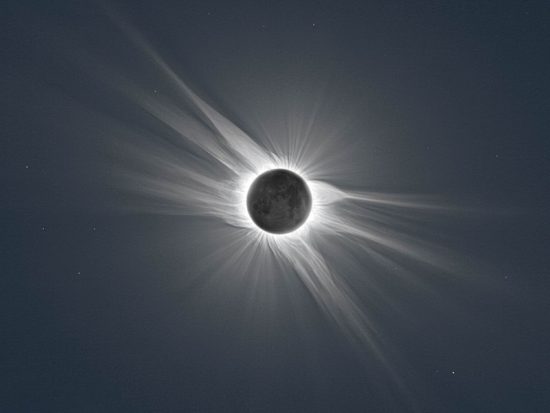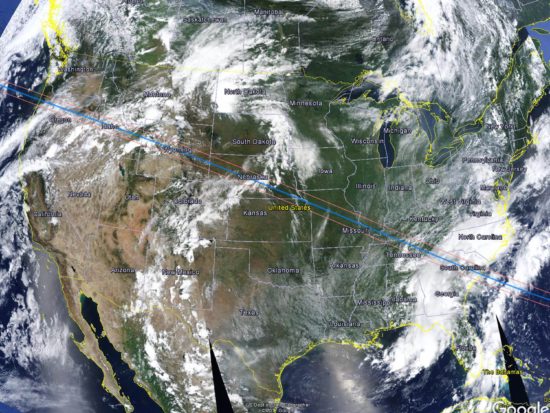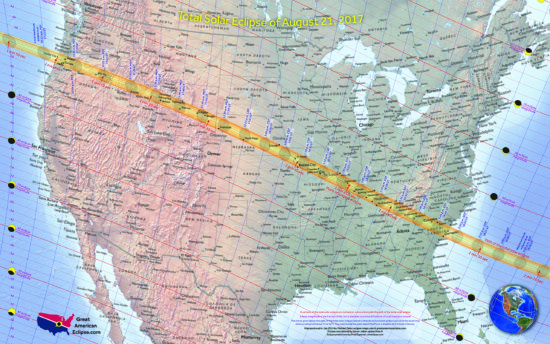
The March 29, 2006 total solar eclipse, composite photo taken from images gathered by 3 separate Canon 5D cameras ranging from 8 sec to 1/1000 sec exposure time (Miloslav Druckmller, Peter Aniol, click image for full-resolution).
The Great American Eclipse of Monday, August 21, 2017 will be one of only a couple of chances for many Americans to experience a total solar eclipse. This is the first coast-to-coast total eclipse since 1918. The last total eclipse visible from any point in the contiguous U.S. was 38 years ago, in 1979. Your next chance will be April 8, 2024.
A total solar eclipse at mid-day will be amazing. If you are in the path of totality, some of the brighter stars and planets will appear. The temperature can fall rapidly.
The following map, provided by greatamericaneclipse.com, has a wealth of information regarding how much of the sun will be covered, at what time, and how long totality will last:
While a partial eclipse will be experienced everywhere in the U.S., where you will want to be is in the narrow (~70 mile wide) path of “totality”, there the moon completely covers the sun. If the skies are partly clear, some of the brighter stars will appear as well as a couple of planets. Totality will last for as long as 2 minutes and 40 seconds.
As long as you are within about 25 miles of the center of the path, you will experience the better part of that maximum time of totality. So (for example), even though Nashville, TN will be 25 miles from the centerline, it will still experience 2 minutes of total solar eclipse.
Safety First!
Since the August 21 eclipse will occur when the sun is high in the sky, it WILL NOT BE SAFE to view it with the naked eyes at any time until totality occurs (the moon completely covers the sun). Until that time, you will need a pair of solar viewing glasses, which are MUCH darker than sunglasses. Do NOT attempt to view the sun with sunglasses, you will permanently damage your eyes. Just before totality, there will be a tiny sliver of bright sunlight…do NOT be tempted to look at it. Solar viewing glasses (and even solar viewing binoculars) might well sell out early, so get them soon.
Will It Be Cloudy?
Climatologically, certain parts of the country will have a greater chance of seeing the eclipse than others. Eclipse2017.org has those probabilities.
But, as a meteorologist I can tell you that weather — not climate — will determine whether you have mostly clear skies or are under a thick thunderstorm anvil.
The following MODIS satellite imagery for mid-day on 21 August 2015 shows that your success will depend heavily upon just what kind of weather systems are occurring and where.

MODIS satellite imagery on 21 August 2015, with the 2017 eclipse path of totality superimposed, showing the wide range of cloud conditions that can occur during a summer eclipse in the United States.
It could be that one of the climatologically best locations (say, north-central Oregon) will be completely cloud covered (as it was on 21 August 2015), while one of the worst places (the Smokey Mountains) will have mostly clear skies if a cool front recently passed by. There is no way to know more than a few days in advance. Thunderstorm anvils blowing off large thunderstorm complexes will likely ruin the experience for many people. This is why I won’t decide where I will go until 1-2 days before the eclipse. I’d love to be in Teton Village for the event, but not if it’s cloudy.
Here in the southeast U.S. in August, even a mostly sunny day will have “popcorn” cumulus clouds that develop by mid-day. One option I’m considering (if that’s the weather forecast) is to go to one of the large reservoirs which tend to stay clear under such condtions, for example Kentucky Lake east of Paducah, or Watts Bar Lake in eastern Tennessee.
But even if you are stuck under the clouds, it is still worth experiencing being in the path of totality. It’s going to get really, really dark in the middle of the day.
To Travel or Not to Travel?
If you live farther than about 6 hours away from the path of totality, and can’t drive there the morning of the eclipse, your other option is to get within 100-200 miles of the path of totality and stay in a hotel the night before, then drive the rest of the way in the morning. Hotels in the path of totality have all been sold out for about a year or so.
I was originally considering going to downtown Nashville, but I’ve heard that hundreds of thousands of people might converge on some of the metro areas, and there could be gridlock. So, I’m still conflicted about whether to go metro or rural.
How to Record the Event?
For most people, just experiencing the event will be magical. Being with a large group of people will raise the excitement level (although if you are easily annoyed by a few overly-excited voices, you might want to avoid crowds).
Now that most people have smartphones, taking some video of the event will be the easiest way to capture the moment. There will be lots of great photos of the sun itself after the event, and they will all look about the same. So, capture the scenery and the reactions of people in cell phone video, instead.
For those of us with heavy-duty photo equipment, we have a number of choices, none of which are easy. Video or stills? If video, real-time or time lapse? Wide-angle landscape shots or zoom in on the sun (with solar filters if not during totality)? I haven’t decided yet. I will probably have one camera on a tripod doing wide-angle video with the sun near the top of the frame, and another camera with a 200-300mm focal length lens taking bracketed exposures of the solar corona over the ~2 minutes of totality, which is what went into the spectacular composite photo at the start of this article.
No matter where we choose to go, happy eclipse hunting, everyone…lets hope for blue skies for as many people as possible!
2017 Eclipse Websites

 Home/Blog
Home/Blog




